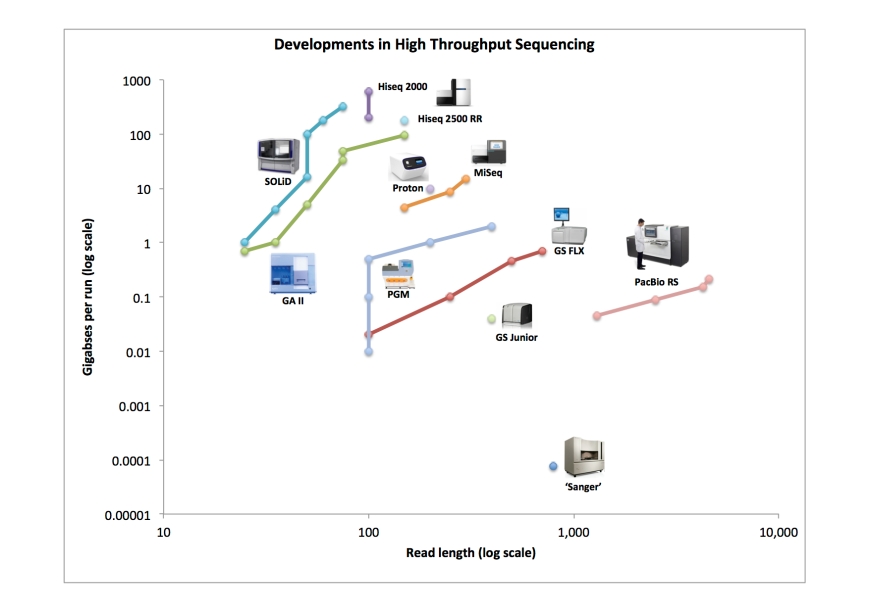In December last year, I posted a visualisation of the developments in high-throughput sequencing on this blog. In this field the technologies change rapidly, so it is about time for an update. Here is the October 2013 installment. Full run throughput in gigabases (billion bases) is plotted against single-end read length, both on a log scale:
Notable changes from the December 2012 edition
- The PacBio RS was upgraded to RS II, making for the most significant change IMHO
- Illumina MiSeq reached 2×300 bp read length
- I added the Illumina HiSeq2500 Rapid Run mode at 2×150 bp
- The Ion Torrent PGM chips upgraded to V2 and got 400 bp read lengths
- The SOLiD came out with a dual FlowChip instrument (5500xl W)
Some comments
- as mentioned in the original blog post: some data was obtained by going to previous versions of company websites through the Internet Archive
- I used full single-run specs with maximally stated throughput
- sometimes, the total numbers of reads per full run and total bases obtained do not match up; for the figure, I always chose the reported throughput in bases
- for Illumina, I chose to use the single-end read length, although the maximum throughput was based on the sum of all reads from a paired end run; I felt it unfair to double the read length for this platform for the figure
Availability
Data and figures are released under a CC0 license at figshare, with doi dx.doi.org/10.6084/m9.figshare.100940. I’ve also added the content to Github at https://github.com/lexnederbragt/developments-in-next-generation-sequencing.
Disclaimer
As before: although I took utmost care in collecting the data, I may have gotten some of my numbers completely wrong, for which I apologise in advance; please help me correct any mistakes or omissions through leaving a comment, or sending me a pull request.


Thanks for the update, I’m curious what’s going on with the 250 bp reads on HiSeq 2500. They tweeted in January, and is supposed to arrive before the end of the year: https://twitter.com/illumina/status/291342510276628480
Also, the Proton read lengths seems a bit stagnant.
About the HiSeq 2×250, I don’t know, I rely on twitter for that information too :-). About the Proton, perhaps I should have had 100bp or at most 120 bp for the previous version, as 200 bp kind-of came available more recently…
Hi lexnederbragt,
this blog is cool and the picture above is really a very nice summary for the ongoing developments with NGS systems.
May I kindly ask you how to cite correctly in case I would like to use this picture in a presentation? We are doing NGS roadshows, where we also introduce the general principles and read lengths and data outputs, and here such picture would fit almost perfect…
Best regards,
Axel
Thanks! Please cite the figure as follows:
Lex Nederbragt (2013): developments in NGS. figshare. http://dx.doi.org/10.6084/m9.figshare.100940.